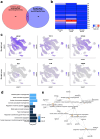Cell-specific expression biases in human cortex of genes associated with neurodevelopmental disorders
- PMID: 40603397
- PMCID: PMC12222695
- DOI: 10.1038/s41598-025-05117-7
Cell-specific expression biases in human cortex of genes associated with neurodevelopmental disorders
Erratum in
-
Correction: Cell-specific expression biases in human cortex of genes associated with neurodevelopmental disorders.Sci Rep. 2025 Sep 9;15(1):32396. doi: 10.1038/s41598-025-18190-9. Sci Rep. 2025. PMID: 40926042 Free PMC article. No abstract available.
Abstract
Up to one third of congenital brain malformations and neurodevelopmental disorders are attributable to single-gene pathogenic variants, and yet we have little understanding of the cellular pathophysiology in the nervous system that arises from these variants. To investigate cortical cell type-specific biases in gene expression associated with distinct neurodevelopmental phenotypes, we integrated phenotypic information from two cohorts of subjects with monogenic neurodevelopmental diagnoses with two human cortical single-nucleus RNA-sequencing (snRNAseq) datasets. Phenotype data was gathered from (1) a single-institution cohort of 84 neonates with pathogenic single-gene variants referred to Duke Pediatric Genetics, and (2) a cohort of 4,238 patients with neurodevelopmental disorders and pathogenic single-gene variants enrolled in the Deciphering Developmental Disorders study. Human cortical snRNAseq datasets were obtained from public repositories and included 86 samples from human cortex spanning the 2nd trimester of gestation to adulthood. We identified reproducible cell-specific expression biases for genes in which pathogenic variants are associated with speech/cognitive delay and seizures. Enriched expression of these genes in excitatory neurons or microglia highlights the unique role both cell types play in neurodevelopment. Moreover, this information illuminates distinct cortical cell types that are more likely to be impacted by pathogenic variants and may mediate their symptomatology.
Keywords: Congenital brain malformations; Human cortex; Neurodevelopmental disorders; Seizures; Single nucleus RNA sequencing; Speech and cognitive delay.
© 2025. The Author(s).
Conflict of interest statement
Declarations. Competing interests: The authors declare no competing interests.
Figures





References
-
- Nomura, M. L. et al. Congenital hydrocephalus: gestational and neonatal outcomes. Arch. Gynecol. Obstet.282, 607–611. 10.1007/s00404-009-1254-2 (2010). - PubMed
-
- Van den Veyver, I. B. Prenatally diagnosed developmental abnormalities of the central nervous system and genetic syndromes: A practical review. Prenat Diagn.39, 666–678. 10.1002/pd.5520 (2019). - PubMed
MeSH terms
Grants and funding
LinkOut - more resources
Full Text Sources

